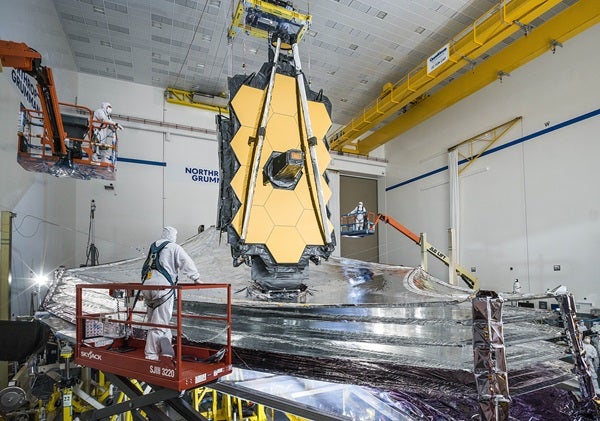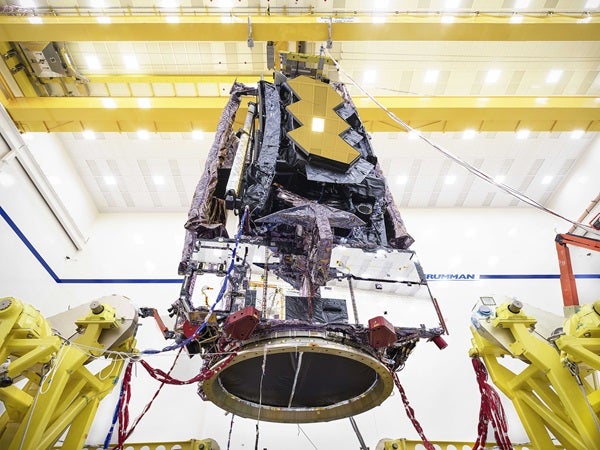So far, for the James Webb Space Telescope (JWST), everything’s cool — and getting cooler.
That’s because on Jan. 4, NASA’s newest flagship observatory successfully deployed its sunshield, a tennis court-sized parasol that will keep its mirrors and sensitive instruments permanently shaded from the Sun.
The deployment is a major milestone in the complex and risky procedure of bringing the telescope online. Since JWST launched Dec. 25 from French Guiana, the operations team at the Space Telescope Science Institute in Baltimore has been meticulously working to deploy each of the observatory’s parts and systems from the folded-up compact configuration that it launched in.
This complex series of procedures is full of potential pitfalls, but the sunshield, in particular, was one of the trickiest parts and is crucial to the entire design of the telescope.
It consists of five kite-shaped layers of an aluminum-coated film about 70 feet (21 meters) long and 54 feet (16 m) wide. As the name suggests, it blocks the heat of the Sun (as well as Earth), allowing the telescope to cool to –370 degrees Fahrenheit (–223 degrees Celsius). But it also acts as a radiator, dissipating heat from JWST’s computers and other support systems and stopping it from bleeding to its instruments. Both functions are necessary for the telescope to observe at the infrared wavelengths that will allow it to peer back in time across the universe to some of the earliest galaxies.
Flexible timeline
To deploy the sunshield in space, NASA first unfolded the sunshield’s fore and aft support structures and raised the tower that the telescope itself sits on, creating room for the shield to unfold beneath it. Then, late on New Year’s Eve, the team extended the booms that stretched the shield to its full width. Finally, each individual layer had to be pulled taut, or tensioned, around their frames. In all, the process involved 139 release mechanisms, 70 hinge assemblies, eight motors, 90 cables, and about 400 pulleys.
NASA took a deliberate approach to the tensioning, delaying the process a couple days after two concerns arose — both related to the telescope’s thermal characteristics. First, the array of solar panels was providing less power to the telescope than expected. And second, the sunshield deployment motors were hotter than expected, though not hotter than their design limits.
To address the first issue, Northrop Grumman, which assembled JWST in Redondo Beach, California, analyzed the efficiency of each solar panel in the array. While the array’s factory preset had each panel operating at the same voltage, once in space, each one had slightly different temperatures and thus, slightly different efficiencies. The hotter they were, the less efficient. Understanding how each panel was performing allowed the team to reprogram the arrays to distribute the load more effectively between each panel — enough to power the observatory and keep the battery topped off.
Then, to cool the deployment motors, the team adjusted the orientation of the telescope slightly. “They’re nice and cool,“ said Amy Lo, JWST’s lead vehicle engineer at Northrop Grumman. “We’ve got a lot of margin now on our temperature.”
After resolving both issues, the team began tensioning the sunshield layers Jan. 3.
Tension and relief
The tensioning of the final layer came on the morning of Jan. 4, as the U.S. capital area was blanketed by a snowstorm. And with cases of the omicron variant of COVID-19 soaring, most team members were working from home; only the minimum amount of staff were in the mission operations center in Baltimore.
Against the backdrop of these additional challenges, checking the sunshield deployment off the team’s list was a major relief. “I’d be wiping my forehead if you could see me,” said Bill Ochs, the telescope’s project manager on a Jan. 3 media teleconference. “That was really a huge achievement for us.”
During the telescope’s development, an engineering report identified 344 separate ways that the process could go wrong and render the telescope unable to fulfill its mission. With the sunshield fully deployed and tensioned, Ochs estimated that 70 to 75 percent of these single point failures are now behind the team.
The telescope passed another milestone today when it deployed its secondary mirror. “This is unbelievable,” said Ochs. “We’re about 600,000 miles from Earth, and we actually have a telescope.” The largest remaining item in the deployment procedure is to unfold the wings of JWST’s 6.5-meter gold-coated primary mirror, which Ochs said the team should tackle by this weekend.











